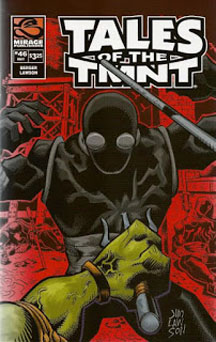The 2008 batch of “Tales of the TMNT” Volume 2 was defined in two major ways: One, editor Dan Berger began informing readers of where each tale takes place on the timeline; and two, Jim Lawson began regularly contributing artwork. With Volume 4 producing no more than one comic per year at this point, Lawson was free to draw eight of the 12 “Tales” issues in 2008.
Mind control
While Berger’s attention to timeline placement was a nice touch, one of the amusing oddities of the “Tales” project was that even as it attempted to answer questions about past storylines, it often created new questions. A notable example is Berger’s Issue 49 (“Mined Games”).
In the editorial, Berger claims that “one of the most-asked queries Mirage receives about the comics is ‘What exactly happens at the end of Volume 2?’ ” To me, the problem with the end of Volume 2 is that it’s rushed and not very good; it does, strictly speaking, come to a conclusion.

“Tales of the TMNT” Volume 2 Issues 42-53 (2008)
Writers: Dan Berger, Peter Laird, Jake Black, Stephen Murphy, Ryan Brown, Tristan Huw Jones, Jim Lawson
Pencils: Jim Lawson, Dario Brizuela, Paul Harmon, Dan Berger
Inks: Jim Lawson, Dario Brizuela, Gary Fields, Dan Berger, Michael Dooney, Eric Talbot, Paul Harmon
Here, Braunze meets up with the Turtles again to restore their memories of the Nevada adventure, only to find that their memories are already returning. Unless I really wasn’t paying attention during Volume 2, it seems that “Mined Games” actually adds two female characters who – unlike Braunze – use their mind-control powers for evil. So it’s not so much a conclusion as it is one more Volume 2 story.
Speaking of mind-control, the Turtles have to overcome the magical powers of the evil mayor of Springfield in Jake Black’s Issue 48 (“The Decider!”), which I enjoyed largely because it’s set during the classic farmhouse era. Black keeps the theme going as a more subtle form of mind control is at work in Issue 47 (“The Secret Origins of the Super Turtles!”), which gives the backstory of the Super Turtles from Volume 4, Issue 7.
In a blunt parable for this century of the War on Terror, NSA spying and eroding liberties, the Super Turtles are used by a world president as weapons to protect his power in the guise of defending the Earth against a non-existent alien threat. When confronted with the reality of their situation, the Turtles immediately recognize their error and fight for good; if only it were that easily in the real world!
It’s interesting that in the Super Turtles’ alternate reality, people are scared of aliens, but in the actual Mirage timeline, people openly welcome the Utroms in Volume 4, Issue 5 (with the notable exceptions of the Madhattan Maulitia and the xihadists).

In Berger’s Issue 42 (“The Curious Case of Mr. Jones”), set just before Volume 4, the Utroms abduct Casey and quiz him; in the end, we learn that this was an Utrom test to see if Earthlings are psychologically prepared for aliens. The highlight is Casey’s facial expressions, awkward lies and paranoia in front of the increasingly exasperated Utroms.
Christmas past
Another nice dose of comedy comes in Lawson’s Issue 53 (“Alien Invaders”). While it’s not as much of a tie-in to the 1985 “Michaelangelo” one-shot as a reader might hope, it’s still a lot of fun to see a Lil’ Orphan Alien collector/thief scared off the farm by the alien-disguised Turtles.
The highlight of this issue, though, is Berger’s back-up story, “Ghosts of Christmas Past.” It’s basically just an older Leo revisiting the rooftops where he was overpowered by Foot soldiers in the “Leonardo” one-shot, but the art by Chad Hurd with toning by Sam Ellis is notably outstanding for how it nails the shadows of a snow-covered city at night, just a bit outside the glow of streetlights.
I don’t usually mention art in these reviews, because I’m more of a story guy and I don’t have an art-critic vocabulary, but this work really jumped out at me.
Halloween horror
Issue 53 is clearly Christmas-themed, but Halloween-style horror dominated three issues in 2008. Lawson’s Lovecraftian Issue 45 (“Rocks”) has a great final panel. Raph, Don and Mike (Lawson amusingly passes on trying to write Leo into this yarn) encounter an underground monster who explains that his cave is collapsing due to the rocks that crack with every human lie or betrayal in the world above.
After the Turtles escape, Raph tells his brothers, “If there’s one thing you can count on, it’s that we will always be there for each other.” “Crack!” goes the rock in the foreground. This is a cool zinger when one considers the bleak Future Turtles tales that readers have become fairly familiar with by this point.
Berger’s Issue 51 (“Night of the Living Gingerbread”) is a throwaway goof that might not even be canon, as it’s actually Mike telling a bedtime tale to Shadow. Renet, in a parody of her ditzy teenage persona from the early days (which bordered on parody to begin with), zaps the Turtles into a zombie-, werewolf- and vampire-infested dimension. For those of you who keep obsessive track of crossovers, Berger’s gingerbread-man character Gutwallow guest stars.
(Speaking of crossovers, Ryan Brown’s C.O.W.-Boys of Moo Mesa make their third appearance in Issue 52, “The Crystal at the Heart of the World,” which features an outright evil sect of Utroms along with “TMNT Adventures’ “ Cudley the Cowlick, who strikes a sense of déjà vu in Donatello.
A full year before the “Turtles Forever” TV movie, this is a strong hint that each Turtles reality exists as part of a larger multiverse, and – who knows? — perhaps they are all accessible via the Utroms’ Cosmic Stigmatifier Monitor or Renet’s scepter.)
Completing a horror trifecta, Tristan Jones’ Issue 50 (“World’s Deadliest”), although more convoluted than it needs to be, boils down to a “Most Dangerous Game” riff featuring Leatherhead, the Turtles and unusually dark art by Paul Harmon. The back-up story, “Threads,” is notable for being the second-earliest story on the timeline, according to TMNT Entity, as it shows the Utrom doctor adopting a baby Leatherhead.
Karai and Casey
The honor of earliest story on the Mirage timeline goes to Black’s Issue 44 (“The Amulet”), but that’s about the only thing it’s notable for. Although it’s a Karai story, it doesn’t do much to flesh out her origin story. Fitting her usual characterization, she’s evil (she is a member of the Foot Clan) but not as evil as all of her brethren (she tries to stop a colleague from acquiring a powerful amulet).
Karai’s truce with the Turtles in “City at War” made her an intriguingly out-of-the-box antagonist, but for some reason she diverts to full-on clichéd villain mode in Berger’s Issue 43 (“The Proposal”), which otherwise has a lot to recommend it.
This is the landmark issue where Casey proposes to April, and that part is handled quite well, with the Turtles helping Casey out by bringing him his tuxedo after he panics and flees into the woods. For the second time (the first is “Tales” Volume 1, Issue 1), we meet Casey’s cousin Sid, who is trying to join the Foot and steal the ring Casey intends to give to April. While Sid’s a nasty guy, I don’t think he deserved the fate of being tortured by Foot mystics and locked up in a dungeon.
Men behind the masks
Sid’s tragic story is one of many “meet the men behind the masks” Foot soldier tales throughout “Tales” Volume 2; others include Cha Ocho and Hana Yoshi.
And another one comes in Berger’s Issue 46 (“Temps”). Although we can see where this story is going the whole way, this is still my favorite issue from 2008 because it takes place smack-dab during “City at War” – the Turtles are even in the ol’ water tower – and the first-person perspective of a Foot soldier who ends up being stabbed to death by Raphael packs quite a punch.
The kid is essentially the first movie’s Danny Pennington (actually, he’s a more likable version of Danny), except that through youthful stupidity and cruel happenstance, he gets killed before he can learn the folly of joining the Foot Clan.
“Temps” is also a rare issue that makes it explicitly clear that the Turtles sometimes kill people in their fights, and that’s a major element that gives Mirage a bit more depth than other “TMNT” incarnations such as the movies, Archie comics and cartoons.
While I don’t mind a fun issue every now and then, it’s serious ones like “Temps” that resonate and remind me why “TMNT” is such a great book.

